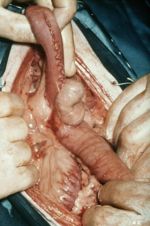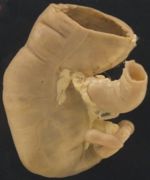Difference between revisions of "Caecum - Anatomy & Physiology"
Jump to navigation
Jump to search
Fiorecastro (talk | contribs) |
|||
| (22 intermediate revisions by 6 users not shown) | |||
| Line 1: | Line 1: | ||
| − | {{ | + | {{toplink |
| − | == | + | |backcolour =BCED91 |
| − | [[Image:opendogcaecum.jpg|thumb|right| | + | |linkpage =Alimentary - Anatomy & Physiology |
| − | [[Image:Caecum and appendix of gibbon.JPG|thumb|right| | + | |linktext =Alimentary System |
| − | + | |maplink = | |
| − | The | + | |sublink1=Large Intestine - Anatomy & Physiology |
| + | |subtext1=LARGE INTESTINE | ||
| + | }} | ||
| + | <br> | ||
| + | ==Introduction== | ||
| + | [[Image:opendogcaecum.jpg|thumb|right|150px|Dog caecum, ileum and colon - © RVC 2008]] | ||
| + | [[Image:Caecum and appendix of gibbon.JPG|thumb|right|150px|Gibbon caecum and appendix- © RVC 2008]] | ||
| + | The caecum is a blind ending diverticulum of the large intestine and it exists at the junction of the [[Ileum - Anatomy & Physiology|ileum]] and the ascending [[Colon - Anatomy & Physiology|colon]]. It's size and physiological importance vary between species. It is a site of microbial fermentation, absorption and transportation. | ||
==Structure== | ==Structure== | ||
| − | + | *It communicates with the [[Small Intestine - Anatomy & Physiology|ileum]] via the ileal orifice and with the [[Colon - Anatomy & Physiology|colon]] via the caecocolic orifice. | |
| − | It consists of a base, body and apex | + | *It consists of a base, body and apex, the apex being the blind-ending portion. |
| + | *It is attached to the [[Small Intestine - Anatomy & Physiology|ileum]] by a fold of peritoneum called the '''ileocaecal fold'''. | ||
==Function== | ==Function== | ||
| − | ''' | + | '''Microbial Fermentation''' |
| − | The contribution of this is [[#Species Differences|species dependant]]. The products of fermentation are [[Volatile Fatty Acids| | + | *The contribution of this is [[#Species Differences|species dependant]]. The products of fermentation are [[Volatile Fatty Acids - Anatomy & Physioogy|VFAs]]. |
| − | ''' | + | '''Absorption''' |
| − | VFAs that are produced are absorbed here. | + | *VFAs that are produced are absorbed here. |
| + | |||
| + | '''Transportation''' | ||
| + | *Segmental contractions facilitate absorption and microbial actitivity. | ||
| + | *Every 3-5 minutes, segmentation is replaced by ''mass movements''. This is similar to peristalsis, but large portions of the caecum contract simultaneously to move chyme into the [[Colon - Anatomy & Physiology|colon]]. | ||
| + | |||
| + | ==Histology== | ||
| − | + | *No villi | |
| − | + | *Mucosa has mucous glands | |
| + | *Lamina muscularis has large lymphatic nodules. | ||
| + | *Submucosa has no glands. | ||
==Species Differences== | ==Species Differences== | ||
===Canine=== | ===Canine=== | ||
| − | + | *On the right side of the abdomen. | |
| + | *Unique because it has no direct connection to the [[Ileum - Anatomy & Physiology|ileum]]. | ||
| + | *Short and held in a spiral shape against the ileum by the ileocaecal fold. | ||
| + | *Little microbial fermentation takes place. | ||
===Ruminant=== | ===Ruminant=== | ||
| − | + | *On the right side of the abdomen in the supraomental recess | |
| + | *The apex points caudally. | ||
| + | *Relatively small and featureless: there are no taenia or haustra. | ||
| + | *Some microbial fermentation takes place. | ||
| − | ===[[ | + | ===[[Hindgut Fermenters - Horse - Anatomy & Physiology|Equine]]=== |
| − | A significant amount of fermentation takes place | + | *A significant amount of fermentation takes place. |
| − | |||
===Porcine=== | ===Porcine=== | ||
| − | + | *On the left side of the abdomen, with the apex pointing caudoventrally. | |
| + | *Cylindrical in shape. | ||
| + | *Three taenia are present | ||
| + | **The ''ventral'' taenia provides the attachment for the ileocaecal fold. | ||
| + | **The ''lateral'' and ''medial'' taenia are free. | ||
| − | == | + | ==Test yourself with the Caecum flashcards== |
| − | + | *[[Caecum - Anatomy & Physiology - Flashcards|Caecum Flashcards]] | |
==Links== | ==Links== | ||
| − | + | *[[Intestines, Small and Large - Pathology|Pathology of the Small and Large Intestines]] | |
| − | + | *[[Peyer's Patches - Anatomy & Physiology|Peyer's Patches]] | |
| − | + | *[http://stream2.rvc.ac.uk/Anatomy/bovine/Pot0048.mp4 Pot 48 The Small and Large intestine of the Ruminant] | |
| − | + | *[http://stream2.rvc.ac.uk/Anatomy/bovine/Pot0052.mp4 Pot 52 Lateral view of the Abdomen of a young Ruminant] | |
| − | + | *[http://stream2.rvc.ac.uk/Anatomy/equine/Pony_abdomen.mp4 Lateral View of the Equine Abdomen] | |
| − | + | *[http://stream2.rvc.ac.uk/Frean/Pony/left_topography.mp4 Left Sided topography of the Equine abdomen] | |
| − | + | *[http://stream2.rvc.ac.uk/Frean/Pony/right_topography.mp4 Right sided topography of the Equine Abdomen] | |
| − | + | *[http://stream2.rvc.ac.uk/Anatomy/feline/pot0357.mp4 Pot 357 The Feline Abdomen] | |
| − | + | *[http://stream2.rvc.ac.uk/Frean/sheep/LargeSmallIntestine.mp4 Small and Large intestine of the Sheep] | |
| − | + | *[http://stream2.rvc.ac.uk/Anatomy/swine/Pig_abdomen.mp4 The Porcine Abdomen] | |
| − | |||
| − | [[Category: | + | [[Category:Alimentary System]] |
| − | |||
Revision as of 13:35, 20 August 2010
|
|
Introduction
The caecum is a blind ending diverticulum of the large intestine and it exists at the junction of the ileum and the ascending colon. It's size and physiological importance vary between species. It is a site of microbial fermentation, absorption and transportation.
Structure
- It communicates with the ileum via the ileal orifice and with the colon via the caecocolic orifice.
- It consists of a base, body and apex, the apex being the blind-ending portion.
- It is attached to the ileum by a fold of peritoneum called the ileocaecal fold.
Function
Microbial Fermentation
- The contribution of this is species dependant. The products of fermentation are VFAs.
Absorption
- VFAs that are produced are absorbed here.
Transportation
- Segmental contractions facilitate absorption and microbial actitivity.
- Every 3-5 minutes, segmentation is replaced by mass movements. This is similar to peristalsis, but large portions of the caecum contract simultaneously to move chyme into the colon.
Histology
- No villi
- Mucosa has mucous glands
- Lamina muscularis has large lymphatic nodules.
- Submucosa has no glands.
Species Differences
Canine
- On the right side of the abdomen.
- Unique because it has no direct connection to the ileum.
- Short and held in a spiral shape against the ileum by the ileocaecal fold.
- Little microbial fermentation takes place.
Ruminant
- On the right side of the abdomen in the supraomental recess
- The apex points caudally.
- Relatively small and featureless: there are no taenia or haustra.
- Some microbial fermentation takes place.
Equine
- A significant amount of fermentation takes place.
Porcine
- On the left side of the abdomen, with the apex pointing caudoventrally.
- Cylindrical in shape.
- Three taenia are present
- The ventral taenia provides the attachment for the ileocaecal fold.
- The lateral and medial taenia are free.
Test yourself with the Caecum flashcards
Links
- Pathology of the Small and Large Intestines
- Peyer's Patches
- Pot 48 The Small and Large intestine of the Ruminant
- Pot 52 Lateral view of the Abdomen of a young Ruminant
- Lateral View of the Equine Abdomen
- Left Sided topography of the Equine abdomen
- Right sided topography of the Equine Abdomen
- Pot 357 The Feline Abdomen
- Small and Large intestine of the Sheep
- The Porcine Abdomen

